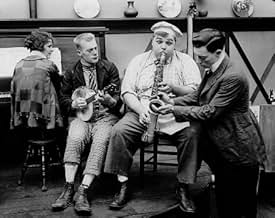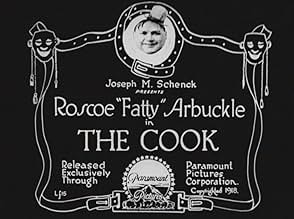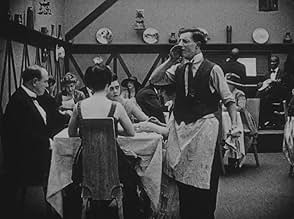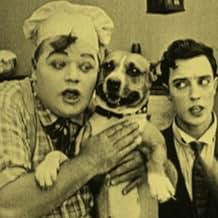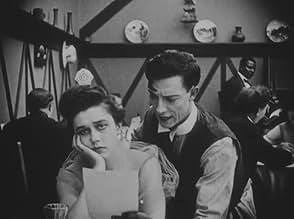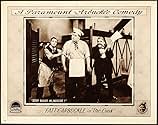Chaos reigns at an upscale restaurant as a cook and a waiter juggle their responsibilities.Chaos reigns at an upscale restaurant as a cook and a waiter juggle their responsibilities.Chaos reigns at an upscale restaurant as a cook and a waiter juggle their responsibilities.
- Director
- Writer
- Stars
- Director
- Writer
- All cast & crew
- Production, box office & more at IMDbPro
Featured reviews
Although I am somewhat biased towards Harold Lloyd, I'm SERIOUSLY infatuated with Fatty Arbuckle comedies now. With a man his size, he was enormously agile, fearless and funny. This is plainly evident in The Cook, a classic example of his often riotous teamings with Stone Face, Buster Keaton. Essentially a bunch of gags which revolve around a restaurant, then an amusement park, Arbuckle just astounded me with his stunt work and clever slight of hand (his cooking stills was outstanding!). And oh dear, this movie is too funny. Many many pratfalls, comedic situations, and great comedic timing.. Seek it out if you can, it's a riot.
What I love about this movie is that it feels like a live action cartoon, one of those Betty Boop-style cartoons where everyone seems to be made of rubber, and even the cars and buildings come to life and bounce to the music. That isn't exactly what happens in The Cook, but it sure is the "cartooniest" comedy Roscoe Arbuckle & Buster Keaton made together. This was the last short Buster appeared in before he shipped off to France for military service in the First World War, so it's all the more striking that everyone appears to be having so much fun. The Cook has a party atmosphere that's contagious, even now.
Most of the action is set in a medium-sized restaurant, where the clientèle is respectable and there's a jazz combo on hand to entertain. Roscoe is the cook, and this of course gives him the opportunity to perform a medley of his favorite food prep gags: flipping pancakes high in the air and catching them behind his back, playing "hacky-sack" with wads of dough, etc. Buster is the waiter, and we're treated to several close-ups that reveal just how amazingly handsome he was at this point in his life. The Cook isn't as violent as some of the other Keaton & Arbuckle shorts, but there's a gag early on that made me gasp: Roscoe is using a meat cleaver to chop a large fish, and when Buster unexpectedly flies headlong into the kitchen and lands on the chopping block, Roscoe brings the cleaver down on his neck! No harm done, however, just like cartoons.
The highlight is an impromptu musical number. An exotic dancer in an Arabian costume is performing for the customers, and although Buster is busy waiting tables the music inspires him to participate. His pseudo-Egyptian "snake dance" is great fun to watch, but back in the kitchen Roscoe manages to top him when he joins in, transforming common kitchen items into a Cleopatra costume. (He also works in a reference to Salome, using a cabbage as the head of John the Baptist.) Most of Roscoe's dance isn't visible to the patrons, he's just clowning back in the back for his own amusement -- and ours, of course. When he dances into the dining room and enhances his act by smashing plates no one is especially shocked or even much surprised, and the finale is greeted with a vigorous round of applause. The mood is downright giddy. Unfortunately the mood darkens when scuzzy Al St. John shows up and manhandles pretty cashier Alice Lake, but the staff at this establishment knows how to handle the undesirable element, and Luke the Dog is soon on call to teach the tough guy some manners. The next sequence features Roscoe, Buster, and two restaurant staffers eating spaghetti in a variety of funny ways; they turn a long strand into an impromptu clothes-line, Roscoe gets the food mixed up with his tie, etc. That's the joy of this film, there's no plot to worry about and no reason to hurry: these guys seem to have all the time in the world to sit around and perform clever gags. (Incidentally, the staffer with the big mustache is John Rand, familiar from a number of Chaplin films; Laurel & Hardy fans will recognize the other gent as Bobby Dunn, the cheerful shoplifter from Tit For Tat.)
The finale takes place in a nearby amusement park, where customers are borne in goat-carts. Al St. John reappears to menace Alice, so Luke obligingly reappears to menace Al. The last shots of the film are missing, unfortunately, but we're lucky we're able to see this much; The Cook was believed to be gone forever until the 1990s, when a portion of the film was found, and that section was matched up with another newly discovered fragment in 2002. The result is a funny and light-hearted comedy, offering modern day buffs a pleasant reunion with two great comedians supported by familiar colleagues, all having a blast.
Most of the action is set in a medium-sized restaurant, where the clientèle is respectable and there's a jazz combo on hand to entertain. Roscoe is the cook, and this of course gives him the opportunity to perform a medley of his favorite food prep gags: flipping pancakes high in the air and catching them behind his back, playing "hacky-sack" with wads of dough, etc. Buster is the waiter, and we're treated to several close-ups that reveal just how amazingly handsome he was at this point in his life. The Cook isn't as violent as some of the other Keaton & Arbuckle shorts, but there's a gag early on that made me gasp: Roscoe is using a meat cleaver to chop a large fish, and when Buster unexpectedly flies headlong into the kitchen and lands on the chopping block, Roscoe brings the cleaver down on his neck! No harm done, however, just like cartoons.
The highlight is an impromptu musical number. An exotic dancer in an Arabian costume is performing for the customers, and although Buster is busy waiting tables the music inspires him to participate. His pseudo-Egyptian "snake dance" is great fun to watch, but back in the kitchen Roscoe manages to top him when he joins in, transforming common kitchen items into a Cleopatra costume. (He also works in a reference to Salome, using a cabbage as the head of John the Baptist.) Most of Roscoe's dance isn't visible to the patrons, he's just clowning back in the back for his own amusement -- and ours, of course. When he dances into the dining room and enhances his act by smashing plates no one is especially shocked or even much surprised, and the finale is greeted with a vigorous round of applause. The mood is downright giddy. Unfortunately the mood darkens when scuzzy Al St. John shows up and manhandles pretty cashier Alice Lake, but the staff at this establishment knows how to handle the undesirable element, and Luke the Dog is soon on call to teach the tough guy some manners. The next sequence features Roscoe, Buster, and two restaurant staffers eating spaghetti in a variety of funny ways; they turn a long strand into an impromptu clothes-line, Roscoe gets the food mixed up with his tie, etc. That's the joy of this film, there's no plot to worry about and no reason to hurry: these guys seem to have all the time in the world to sit around and perform clever gags. (Incidentally, the staffer with the big mustache is John Rand, familiar from a number of Chaplin films; Laurel & Hardy fans will recognize the other gent as Bobby Dunn, the cheerful shoplifter from Tit For Tat.)
The finale takes place in a nearby amusement park, where customers are borne in goat-carts. Al St. John reappears to menace Alice, so Luke obligingly reappears to menace Al. The last shots of the film are missing, unfortunately, but we're lucky we're able to see this much; The Cook was believed to be gone forever until the 1990s, when a portion of the film was found, and that section was matched up with another newly discovered fragment in 2002. The result is a funny and light-hearted comedy, offering modern day buffs a pleasant reunion with two great comedians supported by familiar colleagues, all having a blast.
The epitome of Arbuckle and Keaton's flash-over-substance tendencies. Every last storytelling beat exists solely to maneuver the comic duo into a new backdrop for adlibs and pratfalls. Silent comedy two-reelers will never be known for their rich themes and steep character arcs, but The Cook seems egregious even by those low standards.
Which isn't to say it's without merit. Actually, I really enjoyed myself. The bulk of the film finds our heroes working a high-end restaurant - Arbuckle in the kitchen, Keaton waiting tables - and, despite revisiting a few bits from their first partnership in 1917's The Butcher Boy, remains largely original, averaging a laugh every quarter-minute. It's stuffed with comic gold, from the little throwaway gags (Fatty tossing finished meals over his shoulder, Buster smoothly snatching them from the air) to the more elaborate productions (an explosive, dish-smashing dance number before a raucous dining room). Arbuckle's famous pet bull terrier, distinguished enough to merit his own lengthy Wikipedia entry, even enjoys a few wonderful guest spots as the mayhem spills out to the streets and beyond.
The Cook is great fun - pure, unchained visceral comedy - if you can shut your mind to the dumb plot and just enjoy the sheer physical spectacle of it all.
Which isn't to say it's without merit. Actually, I really enjoyed myself. The bulk of the film finds our heroes working a high-end restaurant - Arbuckle in the kitchen, Keaton waiting tables - and, despite revisiting a few bits from their first partnership in 1917's The Butcher Boy, remains largely original, averaging a laugh every quarter-minute. It's stuffed with comic gold, from the little throwaway gags (Fatty tossing finished meals over his shoulder, Buster smoothly snatching them from the air) to the more elaborate productions (an explosive, dish-smashing dance number before a raucous dining room). Arbuckle's famous pet bull terrier, distinguished enough to merit his own lengthy Wikipedia entry, even enjoys a few wonderful guest spots as the mayhem spills out to the streets and beyond.
The Cook is great fun - pure, unchained visceral comedy - if you can shut your mind to the dumb plot and just enjoy the sheer physical spectacle of it all.
Long believed lost, an extended fragment of "The Cook" has been found, and it confirms how graceful Fatty could be, this time slaving over a hot stove and casually throwing prepared items to an equally blase Buster. Though the film closes at a pier-based amusement park, the kitchen antics are best, with the highlight being two dance pieces--Fatty's tribute to Salome (with salami) and Buster's hilarious rug-cutting with a belly dancer. The vicious (but not malicious) dog is good, too.
10janek303
This is one movie I never will forget. It scores a 10 in all departments: Choreography (unbelievable !), Pacing (Fast and Accurate), Weird (the rendition of "salome" with kitchen stuff as costume, coming out of nowhere, is by far the most decadent stuff to be ever put on a Silent Movie - I mean: Fatty Arbuckle is Genius !) I would have wanted to roll on the floor laughing but it was not possible, because I couldn't get my eyes off the screen, I was THAT amazed by the furious things Buster and Fatty are doing all the time. The humor is outstanding. This Masterpiece was long time vanished, but for god's sake found again. It was the first movie I saw from Fatty, so after that I was a huge fan of him. And Buster - never saw a guy who was more fitting in Slapstick. This Movie is one hell of a ride - GO SEE IT !!!!!
Did you know
- TriviaConsidered lost for several years. A surviving print was found and shown, for the first time in over 70 years, in Venice 1999. The surviving print was found in the attic of a former hospital in Norway. Apparently, the director of the hospital in the 1920s and 30s felt that laughter and comedy helped soothe mentally challenged patients and kept a collection of short films by Buster Keaton, Harold Lloyd and Charlie Chaplin on hand. None of the other short films found were considered lost.
- Alternate versionsThe restored print of "The Cook" runs 21 minutes. It was compiled from a 17 minute print discovered in Norway in 1999 and a 10 minute print discovered in the Netherlands in 2002. Both the restored print and the Norwegian print have a blue color tint, while the Dutch version is in black and white. While all three versions are available on DVD, none include the last minute and a half of the film, which is still considered lost.
- ConnectionsFeatured in Silent Clowns: Buster Keaton (2006)
Details
- Runtime22 minutes
- Color
- Sound mix
- Aspect ratio
- 1.33 : 1
Contribute to this page
Suggest an edit or add missing content


